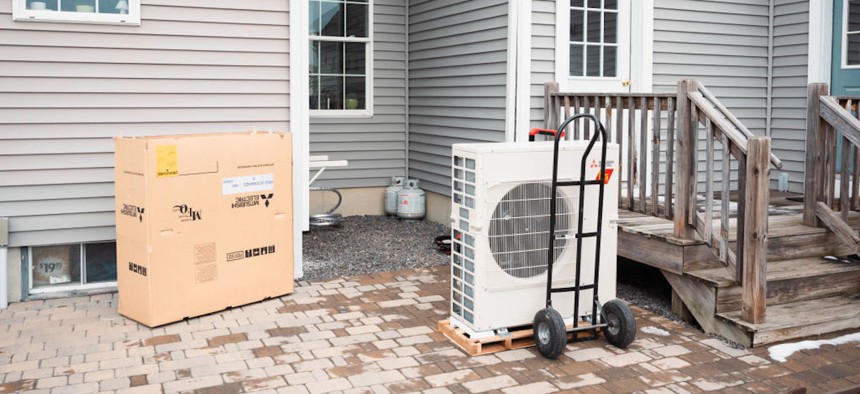A group of US governors promises to install 20 million heat pumps by 2030

An electric heat pump sits ready to be installed at a home in Windham, Maine, on Jan. 19, 2023. Improved energy efficiency with heat pump technology and new tax incentives have contributed to the popularity of heat pumps in New England, as many homeowners are facing increased costs of heating their homes with oil, propane and other fossil fuels. Photo by Tristan Spinski for The Washington Post via Getty Images
And they want to put at least 40 percent of them in disadvantaged communities.
This story is republished from Grist. Read the original article.
Buildings, particularly older ones and those with poor energy efficiency, account for 31 percent of the nation’s greenhouse gas emissions. Beyond contributing to the climate crisis, these structures can saddle their occupants with high utility bills, further burdening those with low incomes.
On Thursday, the U.S. Climate Alliance, an association of 25 governors of states accounting for half of the country’s population, announced a major move to reduce those emissions, cut utility bills, and create jobs. Beyond committing to emissions reduction targets including achieving zero-emission new construction, they promised a four-fold increase in the number of buildings using heat pumps.
Achieving that goal means installing 20 million of the devices by 2030—a tall order indeed. What’s more, the alliance pledged to guide 40 percent of them into disadvantaged communities.
Each state in the coalition has a unique set of goals and tasks ahead to reach the heat pump target. For instance, 10 states, including California, New York, and Hawaiʻi, are adopting zero-emissions standards for space and water heaters. And some states have a headstart on achieving their goals: Maine recently achieved its goal of installing 100,000 of them two years early.
“Transitioning to heat pumps in Maine is creating good-paying jobs, curbing our carbon emissions, cutting costs for families, and making people more comfortable in their homes,” Janet Mills, the state’s Democratic governor, said in a release. “Maine is meeting our climate action goals, and we’re proud to lead the way as part of the U.S. Climate Alliance to encourage other states to do the same.”
The effort is being backed by a combination of funding and incentives from the Inflation Reduction Act and Bipartisan Infrastructure Law. This announcement also builds on previous incentives to increase energy efficiency in older buildings, including a series of tax credits for consumers hoping to switch from fossil fuel appliances to those powered by electricity. The Biden administration recently announced $8.8 billion in rebates for energy-efficiency retrofits for low- and moderate-income households.
Electric heat pumps use much less energy to warm and cool homes and can reduce GHG emissions by an average of 45 percent compared to gas furnaces, making them a major climate solution. A Rewiring America report earlier this year suggested that putting the country on track to meet the Biden administration’s goal of net-zero emission by 2050, Americans will need to buy 2.38 million of the devices over the next three years. Currently, 16 percent of American homes use them, and the administration is intent on bumping that up.
Advocates of the technology say that it’s an essential part of green transition. Stephen Porder, an ecology professor at Brown University and his department’s associate provost for sustainability, is a big fan of heat pumps. He has seen a 50 percent reduction in his energy bills and a 75 percent reduction in his emissions since having one installed in his home 2014. “It’s a win-win-win,” Porder told Grist. But, at least in Rhode Island where he lives, it’s hard to find people to do the work. “We are facing a critical shortage of people to install these heat pumps.”
According to White House climate advisor Ali Zaidi, the collective commitment represents not just an investment in the climate, but an investment in domestic manufacturing and energy efficiency jobs. Many manufacturers have expressed support for the announcement, and Zaidi says several have committed to moving their manufacturing to the United States. The push also will compound a growing nationwide need for electricians.
This announcement follows the impending creation of American Climate Corps, a workforce program that Zaidi says could help provide the workers needed to make the retrofits and installations required to achieve the Alliance’s ambitious goals. Zaidi said the administration has been talking with the national sheet metal workers’ union to develop apprenticeship programs and other pathways for workers to join the energy efficiency sector.
“This is going to require tens of thousands of folks going door to door and installing these heat pumps,” Zaidi said. “If we’re gonna meet our targets, whether it’s in the building sector or the power sector, in resilience and adaptation or climate smart agriculture, we’re gonna need to field a full team here in the United States.”





